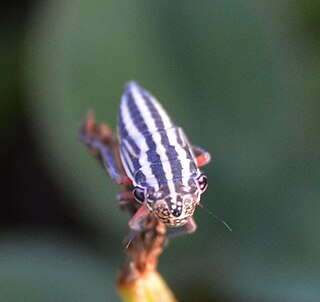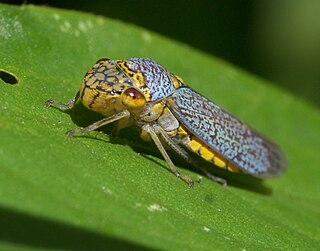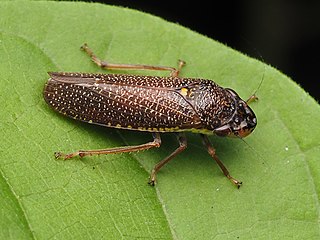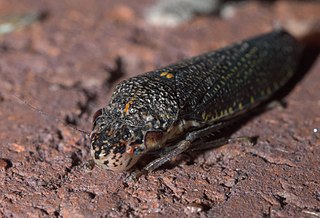
The glassy-winged sharpshooter is a large leafhopper, similar to other species of sharpshooter.

Leafhopper is the common name for any species from the family Cicadellidae. These minute insects, colloquially known as hoppers, are plant feeders that suck plant sap from grass, shrubs, or trees. Their hind legs are modified for jumping, and are covered with hairs that facilitate the spreading of a secretion over their bodies that acts as a water repellent and carrier of pheromones. They undergo a partial metamorphosis, and have various host associations, varying from very generalized to very specific. Some species have a cosmopolitan distribution, or occur throughout the temperate and tropical regions. Some are pests or vectors of plant viruses and phytoplasmas. The family is distributed all over the world, and constitutes the second-largest hemipteran family, with at least 20,000 described species.

Brochosomes are intricately structured microscopic granules secreted by leafhoppers and typically found on their body surface and, more rarely, eggs. Brochosomes were first described in 1952 with the aid of an electron microscope. Brochosomes are hydrophobic and help keep the insect cuticle clean. These particles have also been found in samples of air and can easily contaminate foreign objects, which explains erroneous reports of brochosomes on other insects.

The name sharpshooter is used to refer to any of various genera and species of large leafhoppers in the tribe Proconiini of the family Cicadellidae. As with all cicadellids, they have piercing-sucking mouthparts and closely spaced rows of fine spines on their hind legs. The nymphs feed by inserting their needle-like mouthparts into the xylem of the small stems on the plant where the eggs were deposited; the adults have wings and are highly mobile, and most feed on a variety of different plant species. Both nymphs and adults filter a huge volume of dilute liquid through their digestive system to extract the trace nutrients, and much of the water and carbohydrates are squirted forcibly away from the body in a fine stream of droplets, thus earning them their common name.
Onega is a genus of leafhoppers in the family Cicadellidae.

Gonatocerus triguttatus is a species of fairyfly. It is an egg parasitoid of the glassy-winged sharpshooter, Homalodisca vitripennis. It was originally described from Caroni County, Trinidad.

Cuerna is a genus of sharpshooters in the family Cicadellidae. There are 26 species in this genus. They can be found in North America from Canada and Alaska to Panama, but the highest diversity of species is in the southwestern United States.

Graphocephala versuta is a species of sharpshooter in the family Cicadellidae.

Helochara communis, the bog leafhopper, is a species of sharpshooter in the family Cicadellidae. It has paired mycetomes within its abdomen, containing multiple symbionts.

Oncometopia clarior is a species of sharpshooter in the family Cicadellidae.

Oncometopia orbona, the broad-headed sharpshooter, is a species of sharpshooter in the family Cicadellidae.

Paraulacizes irrorata, the speckled sharpshooter, is a species of sharpshooter in the family Cicadellidae.

Paraulacizes is a genus of sharpshooters in the family Cicadellidae. There are about 11 described species in Paraulacizes.

Sibovia occatoria, commonly known as the yellow-striped leafhopper, is a species of sharpshooter in the family Cicadellidae. It is native to North and Central America, from the United States to El Salvador.

Tylozygus bifidus is a species of sharpshooter in the family Cicadellidae.

Tylozygus geometricus is a species of sharpshooter in the family Cicadellidae.

Xyphon flaviceps, the yellow-headed leafhopper, is a species of sharpshooter in the family Cicadellidae.

Draeculacephala is a genus of leafhoppers. It is one of the most common and widespread genera of leafhoppers in the New World. There are at least 25 described species in Draeculacephala.

Homalodisca insolita, the johnsongrass sharpshooter, is a species of sharpshooter in the family Cicadellidae. It is found in southern North America. It has been identified as a vector of Xylella fastidiosa, a crop-damaging bacterium, and it has been recorded spreading northwards into the south-eastern United States.

Homalodisca liturata, also known as the smoketree sharpshooter or the lacertate sharpshooter, is a species of leafhopper native to North America. The smoketree sharpshooter uses a number of host species but prefers desert smoketree where available. This is a comparatively large leafhopper at approximately 13 millimeters long. It, like other species in its genus, is a known vector of Xylella fastidiosa. Acoustic signaling is known to occur in both male and female smoketree sharpshooters.


















